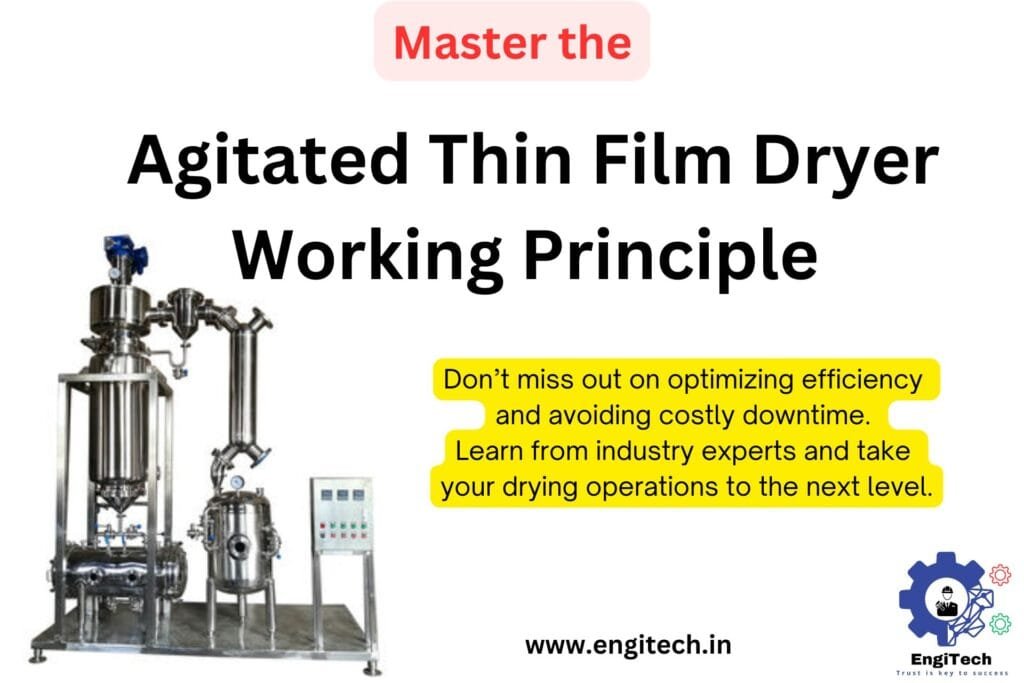Agitated Thin Film Dryers (ATFDs) are advanced industrial drying systems widely used for drying heat-sensitive, viscous, and high-boiling point substances. These dryers stand out due to their efficiency and ability to handle challenging drying applications, making them indispensable in various industries, including pharmaceuticals, chemicals, and food processing. In this detailed guide, we will delve into the working principle of Agitated Thin Film Dryers, providing expert insights into how these machines operate and the advantages they offer.
Introduction to Agitated Thin Film Dryers
Agitated Thin Film Dryers are designed to remove moisture from feed materials, transforming them into dry, solid products. The unique feature of ATFDs is their ability to create a thin film of the product on a heated surface, which significantly enhances the drying process. This thin film formation is achieved through the use of an internal rotor equipped with specially designed blades or scrapers, which continuously agitate the material.
Agitated Thin Film Dryer Working Principle
The Agitated Thin Film Dryer Working Principle revolves around the following key steps:
- Feed Introduction: The process begins with the introduction of the feed material into the dryer. This material can be a solution, slurry, or paste, depending on the application. The feed is usually pumped into the dryer under controlled conditions to ensure a consistent flow.
- Film Formation: Inside the dryer, the feed material is spread into a thin film on the heated inner surface of the cylindrical drying chamber. This is accomplished by the rotor, which is centrally located and equipped with adjustable blades. These blades are responsible for continuously spreading and agitating the feed, ensuring it forms an even and uniform thin film.
- Heat Transfer: The drying chamber’s walls are heated, typically using steam or another heat transfer medium. As the thin film of material comes into contact with the heated surface, heat transfer occurs rapidly. This efficient heat transfer is crucial in reducing the moisture content of the material.
- Evaporation of Volatiles: As the material is heated, the moisture or volatile components begin to evaporate. The continuous agitation provided by the rotor ensures that the film remains thin, allowing for efficient evaporation and preventing the formation of dry spots or crusts that could impede the drying process.
- Vapor Removal: The evaporated volatiles are quickly removed from the drying chamber by a vacuum system or through a forced air flow. The removal of vapors is essential to maintain low pressure within the dryer, which facilitates the evaporation process and prevents re-condensation.
- Product Discharge: Once the drying process is complete, the dry product is continuously discharged from the bottom of the dryer. This discharge process is carefully controlled to ensure that the product meets the desired moisture content and quality standards.
Advantages of Agitated Thin Film Dryers
Understanding the working principle of Agitated Thin Film Dryers highlights several key advantages that make them highly effective in industrial drying applications:
- High Efficiency: The thin film formation ensures rapid and efficient heat transfer, leading to faster drying times compared to other drying technologies.
- Handling of Heat-Sensitive Materials: The short residence time of the material within the dryer minimizes the risk of thermal degradation, making ATFDs ideal for drying heat-sensitive substances.
- Continuous Operation: ATFDs are designed for continuous operation, allowing for a steady output of dried product, which is crucial in large-scale industrial processes.
- Versatility: These dryers can handle a wide range of materials, including those with high viscosity or high boiling points, making them versatile for various applications.
- Reduced Risk of Clogging: The continuous agitation of the feed material prevents the formation of dry spots or crusts, reducing the risk of clogging and ensuring a smooth drying process.
Expert Insights on Optimizing ATFD Performance
For optimal performance of Agitated Thin Film Dryers, consider the following expert recommendations:
- Feed Consistency: Ensure that the feed material is consistent in terms of viscosity and flow rate. Inconsistent feed can lead to uneven film formation and affect drying efficiency.
- Blade Adjustment: Regularly check and adjust the rotor blades to maintain the correct gap between the blades and the heated surface. This adjustment is crucial for achieving an even thin film and preventing material buildup.
- Heat Source Optimization: Choose the appropriate heat source based on the properties of the feed material. Steam is commonly used, but alternative heat sources may be more suitable depending on the application.
- Vacuum Control: Maintain proper vacuum levels within the drying chamber to ensure efficient vapor removal and prevent re-condensation. Regular monitoring of vacuum systems is essential for consistent dryer performance.
- Routine Maintenance: Implement a routine maintenance schedule to check for wear and tear on the rotor, blades, and other critical components. Regular maintenance helps prevent unexpected downtime and ensures long-term reliability.
Conclusion
Agitated Thin Film Dryers are highly efficient and versatile drying systems that play a critical role in various industrial processes. Their working principle, based on the formation of a thin film and continuous agitation, allows for rapid and uniform drying of materials, making them ideal for heat-sensitive and viscous substances. By understanding the key steps involved in the operation of ATFDs and implementing expert recommendations, you can optimize their performance and achieve consistent, high-quality results in your drying applications.
At EngiTech, we are committed to providing you with the latest insights and resources on industrial drying technologies. Stay updated with our blog for more expert advice and innovations in the field of industrial dryers. Explore our comprehensive resources to learn more about how Agitated Thin Film Dryers can benefit your operations.

